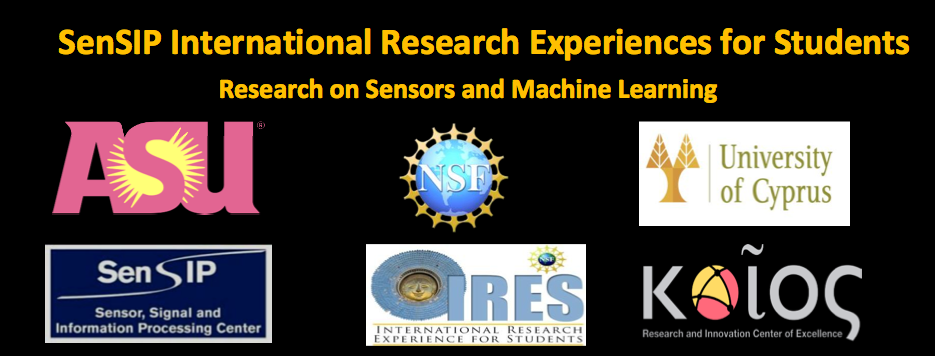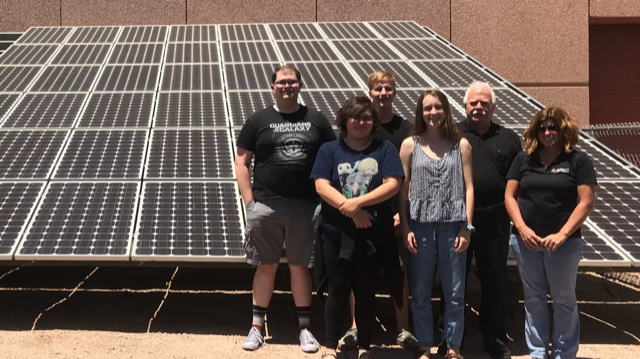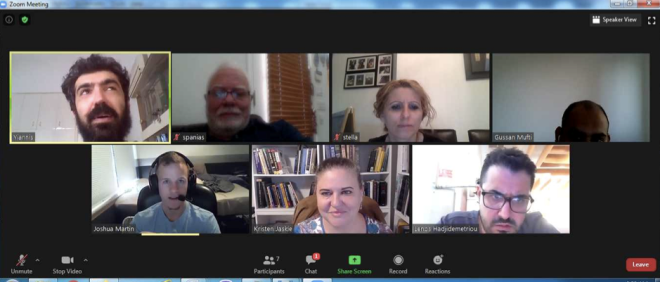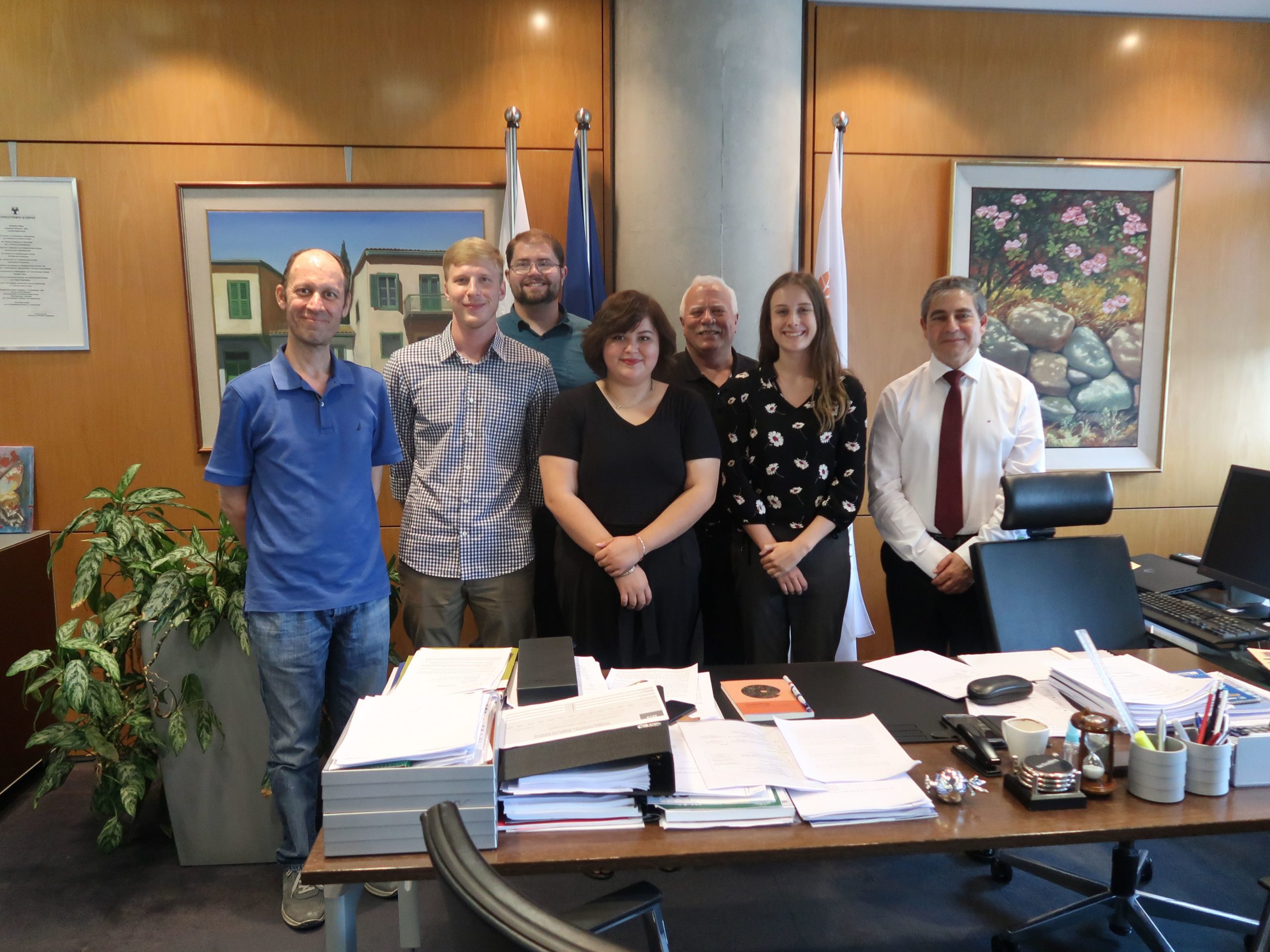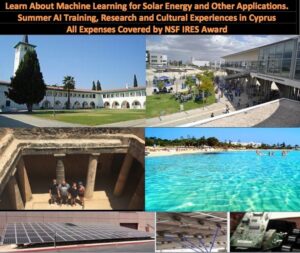Sensors and Machine Learning for Solar Power Monitoring and Control
Program Ended December 31, 2024
NSF IRES UCy KIOS Summer 2024 Schedule: May 15, 2024 – July 12, 2024
Positions Filled. Application Closed!!
NSF IRES Track I: Sensors and Machine Learning for Solar Power Monitoring and Control.
Funded by NSF Award 1854273
Team at ASU:
A. Spanias (PI), SenSIP Center, School of ECEE, Arizona State University,
Wendy Barnard, ASU CREST
Collaborative with the University of Cyprus (UCy) KIOS Center
Faculty Team at UCy:
Elias Kyriakides, Marios Polycarpou, Maria Michael
SenSIP IRES Program in Summer 2020
Because of the Covid-19 restrictions, students were not able to travel to the University of Cyprus. Instead, the program was run virtually with two students, namely, Kristen Jaskie and Joshua Martin that were recruited in late April. The work focused on machine learning for soilage detection. At ASU Andreas Spanias (PI) was the mentor for both students and Wendy Barnard (Co-PI) the program evaluator. At the University of Cyprus, two professors and three faculty (post-doc) associates participated, namely, Dr. Ioannis Tofis, Dr. Lenos Hadjidemetriou, Prof. Maria Michael, Prof. Theo Theoharides, and Dr. Stella Hadjistasou.
The program was presented at the IEEE IISA 2020 conference and a paper [ pdf ] was published in the proceedings of that conference.
IRES Participants Summer 2024:
Leslie Miller, ASU School of ECEE, Graduate Student. She worked on a KIOS project titled: “FixCyprus: Automated Classification of Crowdsourced Reports Using Machine Learning”. She produced a final report in IEEE style and two presentations. Leslie was quite productive and she also collaborated with a 2023 IRES student and together they published two IEEE conference papers. Leslie also submitted a provisional patent.
Report
Gabrielle Miller, (2024), Texas A&M Biomedical Engineering, Undergraduate Student. She worked on a KIOS project titled: “Semantic Segmentation and Classification of OCT Colorectal Polyp Images”. She produced a final report in IEEE style and two presentations. She also submitted with her KIOS advisor a paper to SPIE which was accepted.
Report
Picture at the UCy President Office;
Dr. Laoudias, Prof. Spanias (PI), Leslie Miller, Gabrielle Miller, Dr. Tasos Christofides (rector)
IRES Participants Summer 2023:
Salil Naik, ASU School of SCAI, Topic Quantum SVM Based Positive Unlabeled Learning for PV Fault Detection
Report: Quantum SVM Based Positive Unlabeled Learning for PV Fault Detection
Elevator Pitch Slide
Fiorella Yasmin Estrada, ASU School of ECEE, Topic Maximizing Solar Panel Performance Using Quantum Machine Learning For Fault Detection
Report: Maximizing Solar Panel Performance Using Quantum Machine Learning For Fault Detection
Elevator Pitch Slide
Emma Skaggs, ASU School of ECEE, Topic Classical vs Quantum Neural Networks for Fault Detection in Solar Cell Arrays
Report: Classical vs Quantum Neural Networks for Fault Detection in Solar Cell Arrays
Elevator Pitch Slide
Brent Brightwell, ASU School of ECEE, Topic Quantum Positive Unlabeled Learning for PV Fault Detection
Report: Quantum Positive Unlabeled Learning for PV Fault Detection
Elevator Pitch Slide
For Posters : Click Here
IRES Participants Summer 2022:
K. McGuffie, ASU School of ECEE, Topic Quantum and Classical Machine Learning Algorithm Comparisons for Monitoring PV Array Faults
Report: Quantum and Classical Machine Learning Algorithm Comparisons for Monitoring PV Array Faults
Presentation | Elevator Pitch Slide | Report
T. Irvin, ASU School of ECEE, Topic Quantum Machine Learning for Solar Panel Fault Detection
Report: Quantum Machine Learning for Solar Panel Fault Detection
Presentation | Elevator Pitch Slide | Report
S. Naik, ASU School of ECEE, Topic IRES Cyprus Project: Quantum Machine Learning for Monitoring PV Faults with an Emphasis on Detecting Soiled Panels
Report: IRES Cyprus Project: Quantum Machine Learning for Monitoring PV Faults with an Emphasis on Detecting Soiled Panels
Presentation | Elevator Pitch Slide | Report
N. Kyriacou, ASU School of ECEE, Topic An IRES Experience in Cyprus: Solar Array Fault Detection Using Classical and Quantum Support Vector Classifiers
Report: An IRES Experience in Cyprus: Solar Array Fault Detection Using Classical and Quantum Support Vector Classifiers
Presentation | Elevator Pitch Slide | Report
IRES Participants Summer 2021:
N. Kyriacou, ASU Department of Physics, Topic Surface Albedo Prediction using Artificial Neural Networks
Report: Surface Albedo Prediction using Artificial Neural Networks
Presentation | Elevator Pitch Slide | Poster | Report
S. Budhiraju, ASU CIDSE, Topic Surface Albedo Predictions Using Random Forests
Report: Surface Albedo Predictions Using Random Forests
Presentation | Elevator Pitch Slide | Poster | Report
S. Verch, SenSIP center ASU, Topic Feature Analysis for PV Fault Detection Neural Network Using Linear PCA and Random Forest
Report: Feature Analysis for PV Fault Detection Neural Network Using Linear PCA and Random Forest
Presentation | Elevator Pitch Slide | Poster | Report
M. Yarter, ASU School of ECEE, Topic Feature Study for PV Fault Detection Using Nonlinear Principal Component Analysis
Report: Feature Study for PV Fault Detection Using Nonlinear Principal Component Analysis
Presentation | Elevator Pitch Slide | Poster | Report
CLICK HERE TO VIEW THE VIDEO PRESENTATIONS
IRES Participants Summer 2020:
Kristen Jaskie , ASU PhD ECEE Student, Topic PV Fault Detection using a Feedback Enhanced positive Unlabeled Learning Method
Report: PV Fault Detection using a Feedback Enhanced positive Unlabeled Learning Method
Presentation Award Certificate from Arizona AzSEC (Arizona Student Energy Conference)
Joshua Martin, ASU Senior Undergraduate CIDSE ECEE Student, Topic PV Array Soilage Detection on Cyprus Solar dataset
Report: PV Array Soilage Detection on Cyprus Solar dataset
Presentation
Presentation Award Certificate from Arizona AzSEC (Arizona Student Energy Conference)
Sessions and presentations held via zoom on a weekly basis with the University of Cyprus
Photo Gallery For Summer 2020– Click here
IRES Participants Summer 2019:
Jayden Booth , ASU ECEE Graduate Student , Topic Machine Learning in Communications and Energy Systems ,
Abstract: Machine Learning for Reliable MIMO Systems
Poster
Emma Pedersen , ASU SEMTE Undergraduate , Fault Detection using Radial Basis Networks ,
Abstract: Fault Detection in PV Arrays using Machine Learning Methods
Poster
Jovita Chauvin , ASU CIDSE , Machine Learning for Energy Analytics ,
Abstract: Anomaly Detection for Energy Load Analysis
Poster
Michael Oberdorf , ASU ECEE , Fault Detection using Machine Learning for Rooftop Systems ,
Abstract: Machine Learning for Rooftop PV Fault Detection
Poster
IRES 2019 Cyprus Experiences(Photos)
Summary:
This program promotes international multidisciplinary research at the overlap of sustainability, power systems and signal processing with the aim of improving efficiency in PV power generation. Algorithms for shading prediction and fault optimization will advance the state of the art in remote solar array management. Training students in machine learning, vision and data processing for energy systems is unique and requires an integrative approach. IRES participants will be immersed in producing and understanding solar analytics and creating algorithms and software to control solar arrays. The IRES program will engage faculty researchers from the Arizona State University SenSIP center and from the University of Cyprus KIOS Center in solar energy research. Programs and workshops will be established so that IRES participants are trained in machine learning for energy systems and present their research results in international settings. Weekly presentations at the international site and guidance by international mentors will enrich the cohort research experience. Embedding students in the KIOS center research labs funded by large European Union (EU) grants will provide knowledge on EU and international research practices, energy standards and policies. Students will spend six summer weeks at the University of Cyprus KIOS center to improve their research skills and elevate their cultural competencies. This international research endeavor will energize students to innovate and disseminate results globally.
Technical Description:
Solar energy or photovoltaic (PV) arrays encounter loss of efficiency under conditions of shading, panel faults and temperature variations. In fact, shading, weather patterns, soiling, and temperature reduce power output considerably. For example, a malfunction of one panel will cause an entire PV string to fail. To minimize inefficiencies, individual panel current-voltage (I-V) measurements, weather information, and imaging data are essential. Controlling the power output is possible through solar panel matrix switching and optimization (i.e., changing certain array connections from series to parallel using actuators). Matrix switching (Fig. 1) using programmable relays allows for different interconnection options. The research goal is to optimize PV array systems by: a) exploiting the measured I-V patterns to detect faults using machine learning, b) employing advanced imaging and vision techniques to predict shading, c) using temperature, irradiance and weather data to elevate PV efficiency, and d) include smart grid interfaces. This collaborative IRES project between Arizona State University and University of Cyprus will engage students in the following research problems: a) how do we use imaging to detect cloud movement, predict shading and elevate efficiency; b) how can the array connections be reconfigured based on imaging, weather, and I-V data to elevate efficiency; c) how can we detect and classify panel faults real time using machine learning and other algorithms; d how do we extend these solar monitoring and control concepts from utility-scale solar farms to house rooftop systems?
Prior Publications in Solar Monitoring and Control:
[1] H. Braun, S. T. Buddha, V. Krishnan, A. Spanias, C. Tepedelenlioglu, T. Takehara, S. Takada, T. Yeider, and M. Banavar, Signal Processing for Solar Array Monitoring, Fault Detection, and Optimization, Synthesis Lectures on Power Electronics, J. Hudgins, Ed. Morgan & Claypool, vol. 3, no. 1, Sep. 2012.
[2] Buddha, S.; Braun, H.; Krishnan, V.; Tepedelenlioglu, C.; Spanias, A.; Yeider, T.;; , “Signal processing for photovoltaic applications,” IEEE International Conference on Emerging Signal Processing Applications (ESPA), 2012, vol., no., pp.115-118, Jan. 2012.
[3] Braun, H.; Buddha, S.T.; Krishnan, V.; Spanias, A.; Tepedelenlioglu, C.; Yeider, T.; Takehara; , “Signal processing for fault detection in photovoltaic arrays,”, 2012 IEEE International Conference on Acoustics, Speech & Signal Processing (ICASSP) , pp.1681-1684, March 2012.
[4] V. Krishnan, H.C. Braun, C. Tepedelenlioglu, A. Spanias, “A comprehensive monitoring system for photovoltaic arrays”, Conference on Signal Processing, Pattern Recognition and Applications, Feb. 2012.
[5] S. Peshin, D. Ramirez, J. Lee, H. Braun, C. Tepedelenlioglu, A. Spanias, M. Banavar, and D. Srinivasan, “A photovoltaic (PV) array monitoring simulator,” Proc. Modelling, Identification and Control, 34th IASTED international conference on, Feb. 2015.
[6] H. Braun, S. T. Buddha, V. Krishnan, C. Tepedelenlioglu, A. Spanias, M. Banavar, and D. Srinivansan, “Topology reconfiguration for optimization of photovoltaic array output,” Sustainable Energy, Grids and Networks, 2015, submitted.
[7] H. Braun, S. Peshin, A. Spanias, C. Tepedelenlioglu, M. Banavar, G. Kalyanasundaram, and D. Srinivansan, “Irradiance estimation for a smart PV array,” in IEEE Energy Conversion Conference and Expo, 2015.
[8] H. Braun, S. T. Buddha, V. Krishnan, C. Tepedelenlioglu, A. Spanias, M. Banavar, and D. Srinivansan, “Topology reconfiguration for optimization of photovoltaic array output,” Elsevier Sustainable Energy, Grids and Networks(SEGAN), pp. 58-69, Vol. 6, June 2016.
[9] A. Spanias, C. Tepedelenlioglu, E.Kyriakides, D. Ramirez, S. Rao, H. Braun, J. Lee, D. Srinivasan, J. Frye, S. Koizumi, Y. Morimoto, “An 18 kW Solar Array Research Facility for Fault Detection Experiments,” Proc. 18th MELECON, Technical Co-sponsor IEEE Region 8, T1.SP1.12, Limassol, Cyprus, April 2016.
[10] G. Muniraju, S. Rao, S. Katoch, A. Spanias, C. Tepedelenlioglu, P. Turaga, M. K Banavar, D. Srinivasan, “A Cyber-Physical Photovoltaic Array Monitoring and Control System,” 24 pages, International Journal of Monitoring and Surveillance Technologies Research (IJMSTR), Volume 5, Issue 3, 2018.
[11] S. Rao, S. Katoch, P. Turaga, A. Spanias, C. Tepedelenlioglu, R. Ayyanar, H.Braun, J. Lee, U.Shanthamallu, M. Banavar, D. Srinivasan, “A Cyber-Physical System Approach for Photovoltaic Array Monitoring and Control,” Proceedings 8th International Conference on Information, Intelligence, Systems and Applications (IEEE IISA 2017), Larnaca, August 2017.
[12] A. Spanias, “Solar Energy Management as an Internet of Things (IoT) Application,” Proceedings 8th International Conference on Information, Intelligence, Systems and Applications (IEEE IISA 2017), Larnaca, August 2017.
[13] Farib Khondoker, S. Rao, A. Spanias, C. Tepedelenlioglu, “Photovoltaic Array Simulation and Fault Prediction Via Multilayer Perceptron Models, IEEE IISA 2018, Session TE-1, IEEE Explore 10.1109/IISA.2018.8633699, Zakynthos, July 2018. (5 pages) (Farib REU student)
[14] Sunil Rao, Andreas Spanias, Cihan Tepedelenlioglu, “Solar Array Fault Detection using Neural Networks,” IEEE International Conference on Industrial Cyber-Physical Systems (ICPS), Taipei, May 2019.
[15] Naik, Salil, Glen Uehara, Kristen Jaskie, Leslie Miller, and Andreas Spanias. “Quantum Positive Unlabeled Learning Algorithms with Applications to Energy.” In 2024 IEEE 34th International Workshop on Machine Learning for Signal Processing (MLSP), pp. 1-6. IEEE, 2024.
[16] Martin, J., Jaskie, K., Tofis, Y. and Spanias, A., 2021, July. PV array soiling detection using machine learning. In 2021 12th International Conference on Information, Intelligence, Systems & Applications (IISA) (pp. 1-4). IEEE.
[17] Jaskie, Kristen, Joshua Martin, and Andreas Spanias. “PV fault detection using positive unlabeled learning.” Applied Sciences 11, no. 12 (2021): 5599.
